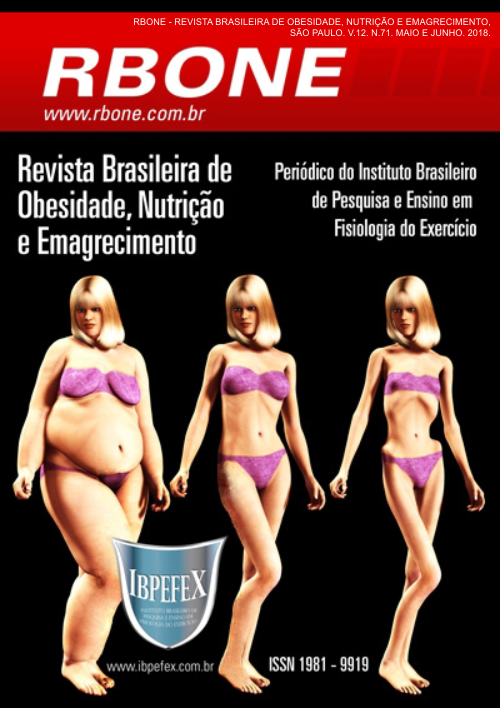Feeding guide for the brazilian population: complementation through graphical representations
Abstract
The aim of this work was to present, assess and elaborate graphical representations to complement the second edition of the Food Guide for the Brazilian Population and facilitate nutrition education. This is a qualitative study, quantitative and participatory. The sample design used was the not probabilistic. Using the dietary guidelines of the food guide was developed the graphical representations. The icon/symbol chosen for drafting was the flag of Brazil. For the evaluation of the same was used the focal group technique. Qualitative analysis and descriptive statistics was conducted. The focal groups were composed of 2% (n = 2) nutrition teachers of the University of the State of Minas Gerais (USMG), unit of Passos-MG, 81% (n = 83) students of nutrition course of USMG and 17% (n = 18) clients/patients of the Nutritional Care Center (NCC) USMG. The median age was 27 ± 12 years, with a minimum of 18 and maximum of 62 years, being 83% (n = 85) female. About the qualitative assessment, the participants understood the associations presented (colors, proportions and food categories) and were able to identify what is a healthy diet and a risk diet by means of graphical representations. Concerning the quantitative evaluation, the mostly of participants pointed out that the material presented improved the concepts about what is food and healthy habits for life (96%; n = 98). In addition, 98% (n = 101) reported that it is important that more people knew and had access to the material (97%; n = 99). It is concluded that the graphical representations may complement the new edition of the food guide and facilitate nutrition education.
References
-ABEP. Associação Brasileira de Empresas de Pesquisa. Critério de Classificação Econômica Brasil 2015. Disponível em <http://www.abep.org/criterioBrasil.aspx>.
-Azevedo, E. Reflexões sobre riscos e o papel da ciência na construção do conceito de alimentação saudável. Rev. Nutr. Campinas. Vol. 21. Num. 6. p. 717-723. 2008.
-Barbosa, R. M. S.; Colares, L. G. T.; Soares, E. D. A. Desenvolvimento de guias alimentares em diversos países. Revista de Nutrição. Vol. 21. p. 455-467. 2008.Disponívelem:<http://www.scielo.br/scielo.php?script=sci_arttext&pid=S141552732008000400010&nrm=iso>.
-Brasil. Ministério da Saúde. Secretaria de Atenção à Saúde. Departamento de Atenção Básica. Guia alimentar para a população brasileira. 2 ed. Brasília: Ministério da Saúde, 2014.
-Brasil. Ministério da Saúde. Secretaria Nacional de Assistência à Saúde. Departamento de Atenção Básica. Coordenação Geral da Política de Alimentação e Nutrição. Guia alimentar para a população brasileira. Brasília: MS, 2006.
-Claro, R. M.; e colaboradores. Preço dos alimentos no Brasil: prefira preparações culinárias a alimentos ultraprocessados. Cadernos de Saúde Pública. Vol. 32. 2016. Disponível em: <http://www.scielo.br/scielo.php?script=sci_arttext&pid=S0102-311X2016000805006&nrm=iso>.
-Claro, R. M.; e colaboradores. Consumo de alimentos não saudáveis relacionados a doenças crônicas não transmissíveis no Brasil: Pesquisa Nacional de Saúde, 2013. Epidemiologia e Serviços de Saúde. Vol. 24. p. 257-265. 2015. Disponível em: <http://www.scielo.br/scielo.php?script=sci_arttext&pid=S2237-96222015000200257&nrm=iso>.
-FAO. Food and Agriculture Organization of the United Nations. Food –based dietary guidelines. 2015. Disponível em <http://www.fao.org/nutrition/educacion-nutricional/food-dietary-guidelines/home/en/>.
-FAO/WHO. Food and Nutrition Board / World Health Organization. Preparation and use of food-based dietary guidelines. Report of a Joint FAO/WHO Consultation. Technical Report Series No.880. Geneva: WHO, 1996.
-Louzada, M. L. D. C.; e colaboradores. Impact of ultra-processed foods on micronutrient content in the Brazilian diet. Revista de Saúde Pública. Vol. 49. 2015. Disponível em: <http://www.scielo.br/scielo.php?script=sci_arttext&pid=S0034-89102015000100238&nrm=iso>.
-Malta, D. C.; e colaboradores. Tendência temporal dos indicadores de excesso de peso em adultos nas capitais brasileiras, 2006-2013. Ciência & Saúde Coletiva. Vol. 21. p. 1061-1069. 2016. Disponível em:<http://www.scielo.br/scielo.php?script=sci_arttext&pid=S141381232016000401061&nrm=iso>.
-Martins, S, Saeki, S.L. Guias alimentares e a pirâmide. Curitiba: Nutroclínica. 2005.
-Minayo, M. C. D. S. Análise qualitativa: teoria, passos e fidedignidade. Ciência & Saúde Coletiva. Vol. 17. p. 621-626. 2012. Disponível em:<http://www.scielo.br/scielo.php?script=sci_arttext&pid=S141381232012000300007&nrm=iso>.
-Molina, V. Guías Alimentarias en America Latina. Informe de la consulta técnica regional de las Guías Alimentarias. Ann Venez de Nutr. p. 31-41. 2008.
-Prates, R. E; Silva, A. C.P. Avaliação do conhecimento nutricional e de hábitos alimentares de pacientes com doenças crônicas não transmissíveis em hospital particular no Sul do Brasil. Revista da Associação Brasileira de Nutrição. Vol. 5. Num. 1. 2013.
-Slow Food Brasil. Manual Slow Food. 2013. Disponível em: <http://www.slowfoodbrasil.com/slowfood/manual-do-slow-food>
-Spexoto, M. C. B.; Ferin, G. G.; Campos, J. A. D. B. Pharmacology and biochemistry undergraduate students’ concern for a healthy diet and nutrition knowledge. Nutr. Hosp. Vol. 31. p. 1813-1823. 2015.
-Viana, M. R.; e colaboradores. A racionalidade nutricional e sua influência na medicalização da comida no Brasil. Ciênc. saúde coletiva. Vol. 22. Num. 2. p. 447-456. 2017. Disponível em:<http://www.scielo.br/scielo.php?script=sci_arttext&pid=S1413-81232017000200447&lng=en&nrm=iso>.
-WHO. World Health Organization. Physical status: The use of and interpretation of anthropometry, Report of a WHO Expert Committee. 1995.
Authors who publish in this journal agree to the following terms:
- Authors retain the copyright and grant the journal the right of first publication, with work simultaneously licensed under the Creative Commons Attribution License BY-NC which allows the sharing of the work with acknowledgment of the authorship of the work and initial publication in this journal.
- Authors are authorized to enter into additional contracts separately for non-exclusive distribution of the version of the work published in this journal (eg, publishing in institutional repository or book chapter), with acknowledgment of authorship and initial publication in this journal.
- Authors are allowed and encouraged to post and distribute their work online (eg, in institutional repositories or on their personal page) at any point before or during the editorial process, as this can bring about productive change as well as increase impact and impact. citation of published work (See The Effect of Free Access).






